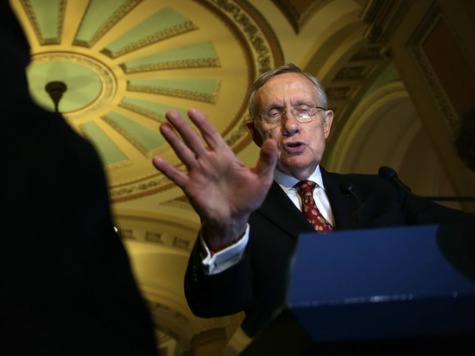
An old rule of politics is to ignore what campaigns say and watch, instead, what they do. Where a campaign devotes its money and resources says more about their view of the landscape than what they say in a press release. According to its recent campaign spending, Sen. Harry Reid’s Senate Majority PAC is building a firewall to defend his majority in states which weren’t viewed as competitive just a few months ago. It is a sign of the deteriorating climate facing Democrats nationally.
So far in this election cycle, the Democrat’s Senate Majority PAC has spent more than $24 million in 10 states. Over $1 million of that was spent attacking Republican candidate Gabriel Gomez in the special election in Massachusetts to fill John Kerry’s term after he was appointed Secretary of State. Overall, more than 90% of its spending has been attacking Republican candidates, rather than promoting the Democrat.
Most political observers estimate that the path to Senate control lies through competitive races for Democrat seats in Arkansas, Alaska, Montana, South Dakota, Louisiana, North Carolina and West Virginia. It has long been expected that Democrat losses in these states could be offset by gaining GOP seats in Kentucky and Georgia. Senate Majority PAC, however, seems to be anticipating a different political battlefield in November.
To date, Reid’s PAC has spent no money in Georgia, Montana, or South Dakota. It has spent just $200k attacking Republican nominee Shelley Moore Capito in West Virginia, a middling figure even for a competitive House race. It has spent some money in Arkansas, Louisiana and Kentucky.
The overwhelming majority of its spending, though, has been in North Carolina, Iowa, Colorado, New Hampshire and Michigan. While North Carolina has always been viewed as a competitive race, the latter five were considered safe Democrat holds at the beginning of the year. These 5 states account for almost 70% of total spending by the Senate Majority PAC.
All of these states are currently showing single digit races in November. Each of these polls, however, is still something of a snapshot, driven by individual name ID and campaigns. These polls are also generally of adults or registered voters and don’t yet reflect partisan enthusiasm or differences in turnout. Any sign of a national wave against Democrats could give Republicans an edge in these states.
Reid’s spending suggests Senate Democrats are equally worried about this scenario. With the traditional start of campaigning still a couple weeks away, the battle for the Senate could move from preserving a Democrat majority to defending against a rout.

COMMENTS
Please let us know if you're having issues with commenting.